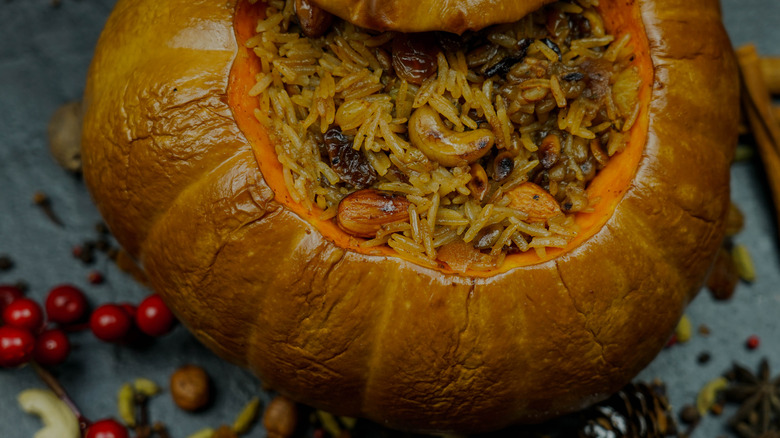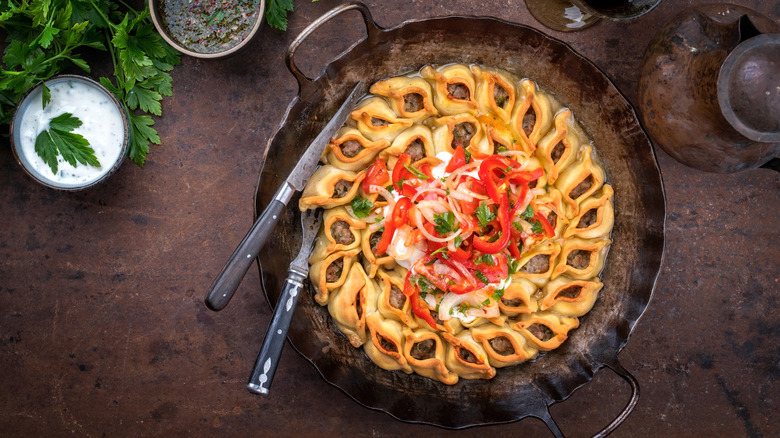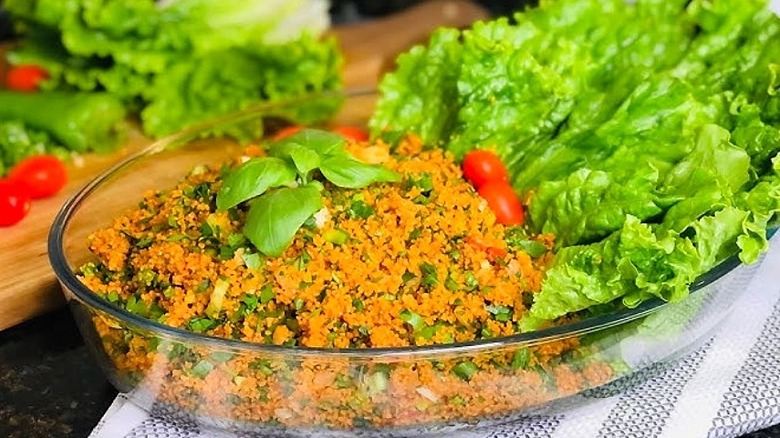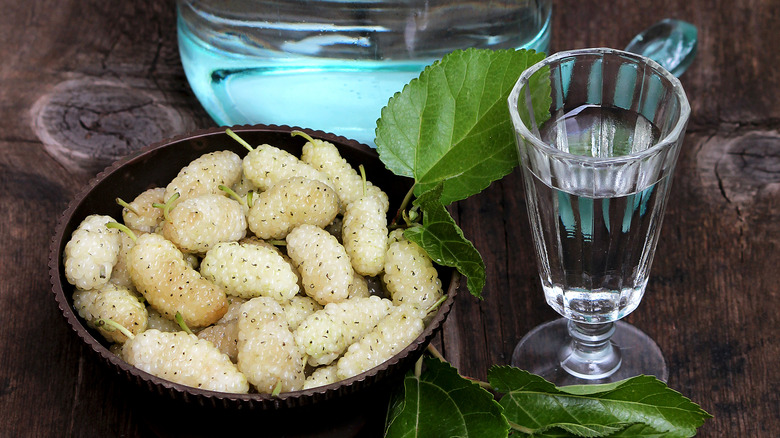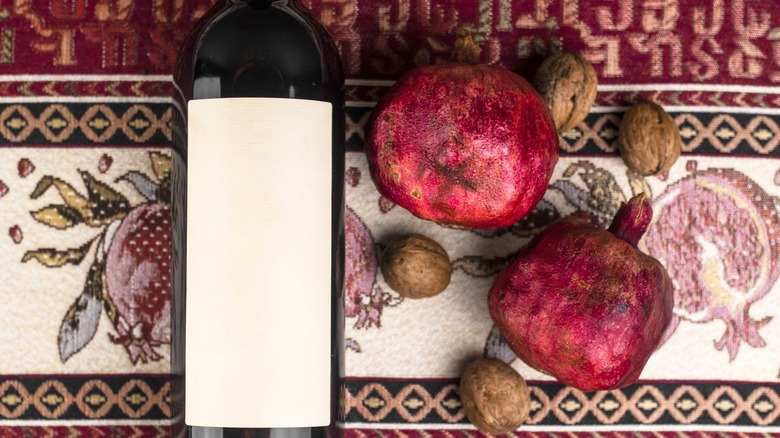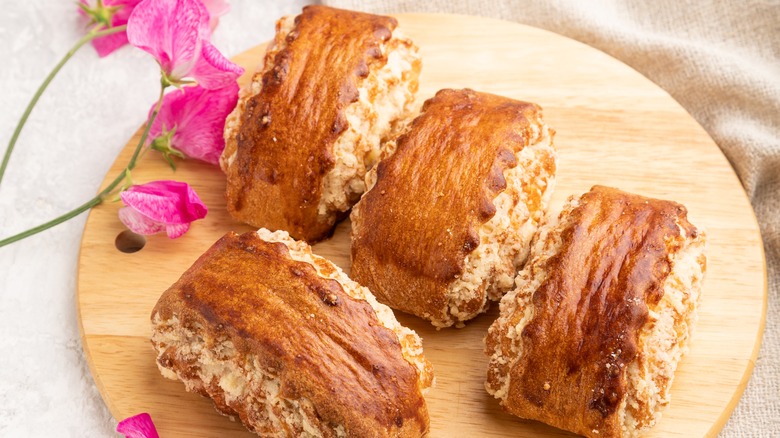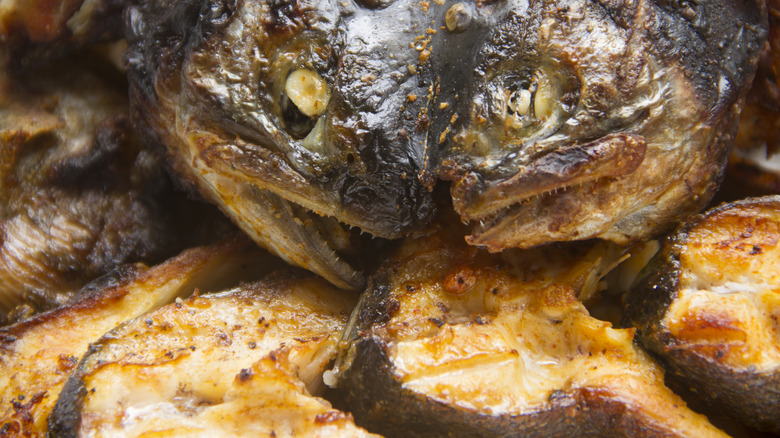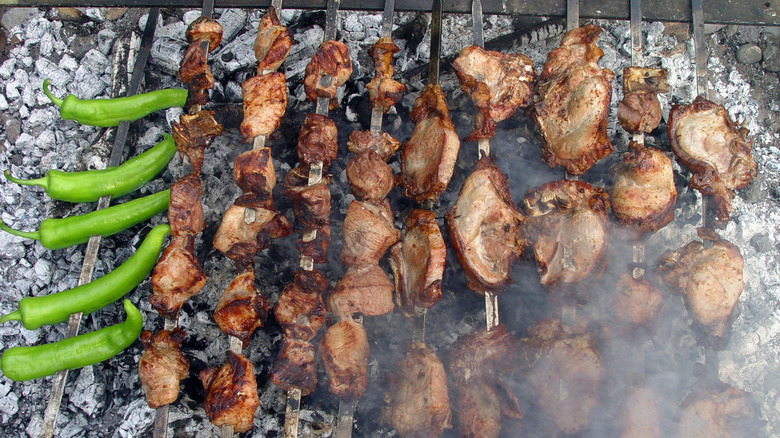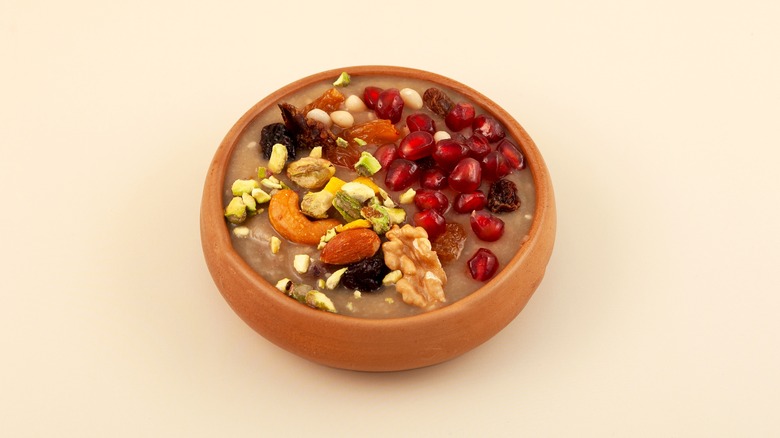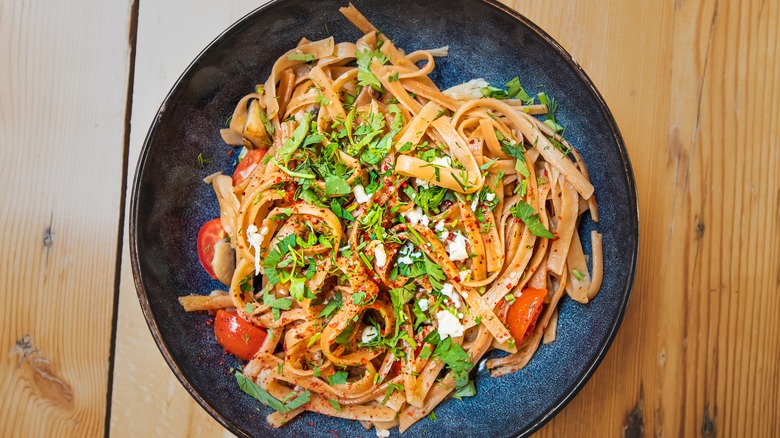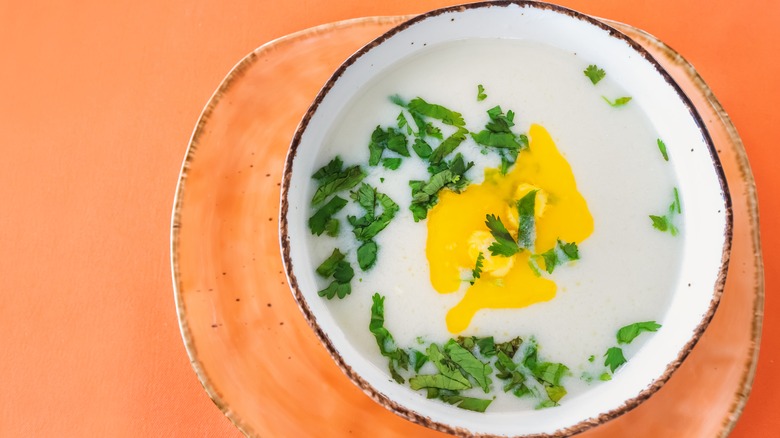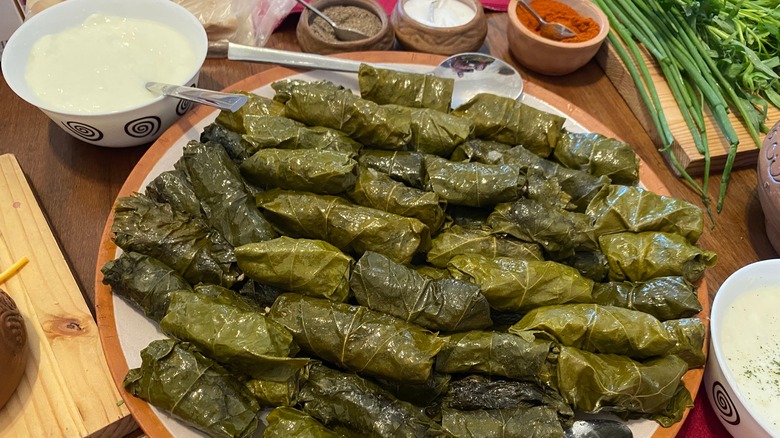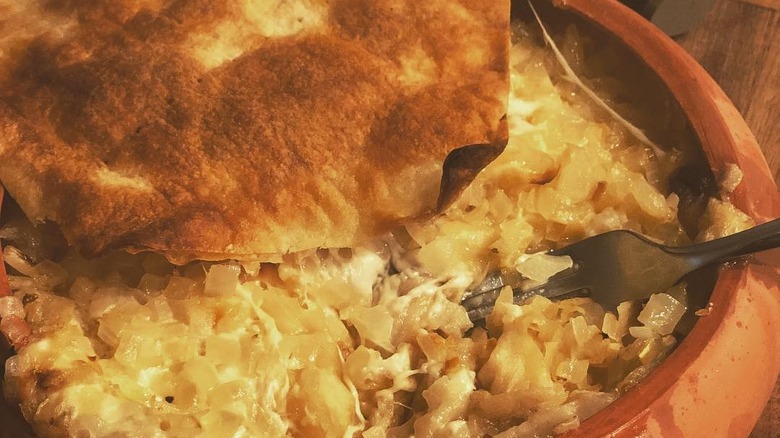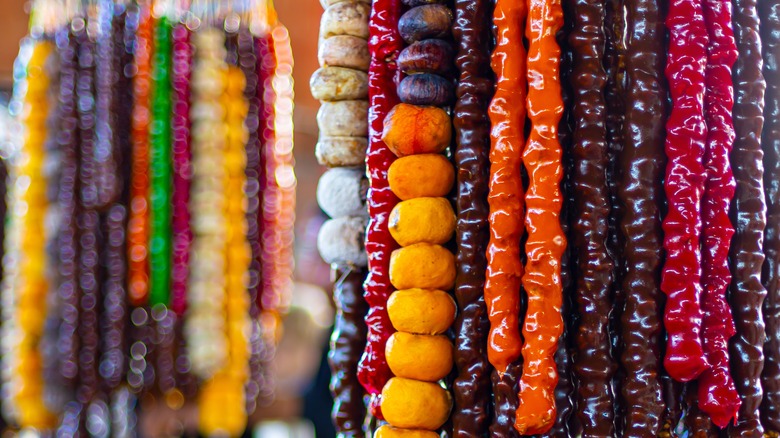15 Dishes And Drinks From Armenia You Need To Try At Least Once
The Caucasus region spreads across Armenia, Azerbaijan, Georgia, and part of Russia. While Georgian cuisine is famous worldwide for its cheese-filled bread boats, neighboring Armenia boasts its own unique lavash flatbread, which accompanies many dishes. Some of the most popular ingredients in Armenian cuisine include pomegranate seeds, apricots, raisins, pork, lake trout, mulberries, bell peppers, walnuts, and cracked wheat, and the combinations of savory and sweet flavors are endless.
It's estimated that up to 2 million Americans are of Armenian descent, with large populations of them residing in Chicago, New York City, and Los Angeles. Many renowned Armenian restaurants can be found in California, such as Zhengyalov Hatz in Glendale — the sole U.S.-based Armenian eatery recommended by the Michelin Guide.
I frequently join my Armenian-Lebanese husband on travels to Yerevan, Armenia's capital city, and after years of delighting in the country's cuisine, I can share my recommended staples. They include hearty savory dishes, irresistible sweet treats, and quality (i.e., strong) alcoholic drinks. Keep these in mind the next time you book a table at an Armenian restaurant — or, if you're lucky, when you take a trip to this ancient nation called the Land of Talking Stones.
1. Ghapama stuffed pumpkin
Many pumpkin recipes can get you in the fall mood, from a decadent pumpkin cheesecake to a pumpkin latte infused with cinnamon, nutmeg, and cloves. Armenians boast their own pumpkin-based delicacy, which is also affiliated with autumn's harvest and widely prepared during the Christmas season.
Ghapama (meaning "cooked in a covered pot") consists of a pumpkin stuffed with rice, honey, nuts, and dried fruits, such as apricots and raisins. Ground meat is an optional addition, while a dessert version of ghapama can be prepared with extra fruit and honey. Some people prefer serving the pumpkin whole with the filling contained inside, while others cut the gourd into large wedges and lay them outward for a more attractive presentation.
With its delicate combination of sweet, savory, and spicy flavors, ghapama is cherished to the extent of inspiring its own theme song, called "Hey Jan Ghapama." The lyrics praise the taste and aroma of ghapama, and it's almost as catchy as the dish is flavorful, with the song often heard during happy occasions that may even involve group dancing.
2. Sini manti baked meat dumplings
Manti is a kind of a meat dumpling, with its Armenian origins likely dating back to the 13th century, though versions of this dish are found from the Balkans to Central Asia. Mouthwatering Armenian sini manti dumplings can be made with ground lamb or beef. Delicately shaped like small canoes, these filled dumplings are arranged decoratively in a round tray or pan.
This dish is lovingly prepared for hours and is baked until the dough is crisp, ideally developing into a shade of golden brown. A rich tomato broth is added to the dumplings in the later stage of cooking, and the dish is served warm with a generous slathering of garlic-infused yogurt sauce and a flavorful garnish of Aleppo pepper and sumac. Vegetarians and vegans can also enjoy this specialty by preparing a filling that is based on mushrooms and spinach instead of meat.
3. Itch bulgur salad
Flavorful, colorful, and filling, Armenia's itch bulgur salad — also spelled "eetch" or "eech" — is similar to tabbouleh, and it can be consumed as an appetizer or a light meal. The recipe typically calls for fine bulgur wheat, tomato paste, onions, chopped scallions, finely diced tomatoes, and seasonings like parsley, dill, garlic, and mint.
This refreshing and hearty salad is usually drizzled with olive oil and/or lemon juice, and scooped into lavash flatbread or lettuce. Variations on the itch recipe can include the use of spicy pepper paste, radishes, pomegranate molasses, and bell peppers of varied colors, any of which may be incorporated into the mix for a more robust flavor.
Once prepared, it's recommended to store itch in the fridge overnight to allow all the juices and flavors to properly infuse the bulgur. Itch is commonly consumed cold, but some serve it warm or at room temperature.
4. Oghi spirit distilled from fruit
Armenia is a highland country, and winters there can get particularly cold, windy, and snowy. To keep warm and energetic, Armenians produce an array of spirits that range from mild to strong, including oghi — which is commonly produced as a type of moonshine. Whether homemade or store-bought, oghi is often distilled from mulberries, but it can also be made with apricots, peaches, apples, and myriad other fruits and berries.
Oghi can be consumed at any time of the day, whether it's served to greet arriving guests, to celebrate good news, or even as a bracing shot in the morning before work — any excuse will do, really. With an alcohol content ranging from 40% to 80%, this drink is certainly potent, and it reigns supreme as an accompaniment for meals, intimate dates, and large gatherings alike. Homemade oghi can be excellent, but some quality commercial brands to sample or bring back as a gift from your trip to Armenia include Ijevan, Artsakh, and Sapor.
5. Pomegranate wine
People in Armenia have been producing wine for a long time — probably for over 6,000 years, as attested by the 2007 discovery of ancient winemaking facilities within the Areni-1 cave complex in Vayots Dzor. That cavern has become a major tourism attraction, and the nearby Hin Areni winery also welcomes the public to display how Armenian winemaking carries on to this day.
While Armenian grape-based wines are popular, perhaps no alcoholic drink is more emblematically Armenian and steeped in tradition than pomegranate wine. In this culture, vibrantly scarlet and tart pomegranate symbolizes fertility and good luck. Its depiction can be found in homes and museums, woven into fabrics, carved into furniture, and across numerous artistic works, such as in "The Color of Pomegranates," the acclaimed 1969 film by groundbreaking Armenian director Sergei Parajanov.
For all of those reasons, pomegranate wine is served with Armenian meals, whether formal or informal. Its tangy and sweet flavor makes it suitable for beef, lamb, chicken, cheeses, and chocolate desserts. Here are some popular brands to sample, offering pomegranate wines in dry, semisweet, and sweet varieties: Matevosyan, Tree of Life, Armenia, and Yerevan.
6. Gata pastries
Flaky, glossy, and not overly sweet, gata is the buttery Armenian cake that pairs perfectly with coffee, not to mention juice, tea, or oghi. The dough is made with milk, butter, sour cream, egg, and sugar, while the filling consists of sugar, butter, flour, and sometimes dried fruits and/or crushed nuts — especially walnuts.
Gata comes in many shapes and sizes, and its top surface can be either plain or embossed with patterns of folk art, Christian symbols, and other pastoral designs. The designs can get quite elaborate on joyous occasions, such as weddings and christenings. Areas of Armenia that are particularly known for amazing gata include Geghard and Garni.
You can find this rustic pastry everywhere, from small village bakeries — often offering the tastiest and freshest gata — to supermarket aisles and restaurants. Its simplicity is what makes it so beloved, and while some people consume it plain, others may dip it in apricot jam, honey, or chocolate sauce.
7. Ishkhan trout
Ishkhan (meaning "prince") is a type of trout that is endemic to Lake Sevan, dubbed Armenia's Blue Pearl. Located in the Gegharkunik Province, this is not only the country's largest lake, but also a prime tourism destination. Numerous legends are told about the origins of Lake Sevan and its ishkhan trout, but it's certainly a true story that Armenians consider this spotted fish as a delicacy — and it's unfortunately also true that ishkhan has been declared as endangered.
Lake Sevan's ishkhan can be prepared in a variety of ways: grilled, braised, boiled, or fried. It's often marinated in wine, and commonly flavored with pomegranate juice, tarragon, green onions, or herbs. The trout is usually served with a side of potatoes, itch, or lavash flatbread.
Another Lake Sevan trout delicacy, called ishkhana, is made by grinding the fish and turning it into balls mixed with spices and egg. The balls are then either boiled in heavily salted water or fried, then drenched in a gravy consisting of flour, onions, and tomatoes.
8. Armenian brandy
There are various types of brandy with a multitude of subtle and pronounced notes, from applejack to cognac to Balkan rakia, but Armenian brandy is uniquely treasured. It's reported that Yerevan features more brandy distillers per capita than any other city around the world. While some claim that brandy has been produced here since the Middle Ages, Armenian brandies have certainly been distilled on a grand scale since the late 1800s, with the prestigious brand Ararat reigning supreme.
Established in 1887, Ararat — named after a massive inactive volcano that holds great significance in Armenian culture — offers a range of brandies made with grapes, cherries, and apricots, along with flavorings like coffee and honey. The core range is aged between three and 20 years, and the ultra-premium variety, called Erebuni, is aged up to 70 years.
What's special about Armenian brandy is that numerous varieties of native grapes are used in the delicate production process, including voskehat, garan dmak, and mskhali. Connoisseurs suggest pairing Armenian brandy with dark chocolate truffles, dried fruits (including apricots), nuts, and matured Armenian cheeses.
9. Khorovats grilled-meat skewers
Derived from the verb "khorovel," meaning "to grill," khorovats are barbecued skewered meats. Grilling is a popular culinary activity in Armenia, especially during celebrations. Khorovats are basically the Armenian answer to kebabs, and they're typically served with lavash flatbread and a salad of chargrilled eggplants, sliced tomatoes, and onions, as well as roasted potatoes.
The meat — be it pork, lamb, beef, or chicken — is cut into sizeable pieces and impaled on large flat skewers. For extra flavor and tenderness, it is supposed to be marinated for many hours. Marinades may include red wine, onion, tomato paste, olive oil, lemon juice, oregano, garlic, and rosemary.
It's safe to say Armenians take a khorovats gathering very seriously, and the accompanying alcohol — whether it's beer, wine, or oghi — can stretch that meal for many convivial hours. Live music and dancing aren't uncommon, either. If you should ever receive an invitation to a khorovats lunch or dinner, it's polite to bring wine, brandy, or seasonal fruits.
10. Anoush abour pudding
Also known as Noah's pudding, anoush abour literally means "sweet soup," and its texture is more similar to porridge than pudding. Typically served on festive occasions and holidays such as Christmas and New Year's Eve, this colorful dessert is often served cold or at room temperature. The main ingredients are whole wheat, water, and sugar, and the mixture can be infused with apricots, raisins, sultanas, honey, pistachios, pine nuts, hazelnuts, walnuts, ground cinnamon, slivered almonds, and the ever-versatile pomegranate seeds.
In case you're wondering where Noah fits in with this nutty and fruity delicacy, the Biblical figure is said to have made that pudding himself while aboard the ark, with an assortment of leftover ingredients that were laying around. As soon as he finished, the rain that had been pouring supposedly stopped. With this lore in mind, Armenians consider this dessert to be a festive dish affiliated with good luck.
11. Arishta thick wheat pasta
Arishta is Armenia's easy, simple, filling, and affordable answer to Italian fettuccine or Asian udon. It is a thick, flat pasta created with wheat flour and cut into long strips. Arishta is typically handmade, though packages of it can also be found at Armenian supermarkets. The traditional arishta recipe calls for the pasta to be served with Armenian matsun — a fermented dairy delight sharing similarities with yogurt and sour cream — along with garlic and clarified butter, but there are many other variations that incorporate cheese, corn, bulgur, mushrooms, onions, tomatoes, and spices.
To celebrate this traditional dish, the Arishta Festival is organized yearly in the village of Bjni, nestled in Armenia's province of Kotayk, which is also known for producing a popular namesake beer. The festival gathers locals and tourists alike to admire artisanal crafts, enjoy live music, and, naturally, watch demonstrations of the lengthy and elaborate arishta-making process.
12. Spas yogurt soup
The best soup recipes around the world are both nutritious and comforting. Some of them can even be consumed hot or cold, and this is the case with the Armenian yogurt soup called spas.
First created in remote villages from simple and accessible ingredients, spas is a creamy, cost-effective, and tangy soup that can be served with spinach or onions fried in butter. The traditional recipe calls for matsun, flour, and wheat berries, with seasonings like cilantro, parsley, mint, and salt added to taste. Contemporary alternatives to the wheat berries include barley, bulgur, and rice, the use of which results in a thicker texture for a more filling soup; adding meatballs is another option to make this dish heartier.
Speaking of meatballs, there are two meatball-based Armenian soups popular for cold winter days. Kololik soup has meatballs made with ground lamb, rice, onions, and parsley, which are added to beef broth flavored with tarragon and basil. Arganak soup features ground-beef meatballs made with rice and onions, which are served in chicken broth infused with lemon juice and egg yolks.
13. Dolma stuffed grape leaves
Dolma is a common name for stuffed grape leaves that are often filled with rice and ground meat, but it may also be made with other vegetable leaves, like cabbage. This dish is found across many Mediterranean, Middle Eastern, and Balkan cuisines, with each region imparting its own special touch. Though it takes ample time to prepare dolmas — starting with preparing the ingredients, then stuffing them into the leaves, and cooking them until tender but firm — this specialty is particularly cherished in Armenia.
Seasonings may include ground cumin, paprika, and black pepper. An alternative version — made by stuffing the filling into red bell peppers — calls for ground lamb, short-grain rice, fresh parsley, onions, garlic, and tomato sauce. Naturally, vegetarians may opt for a meatless version.
If you don't have the time to make dolmas from scratch, you can find this dish in Armenian restaurants, in its many forms. Dolmas may be listed as an appetizer, and served alongside a sauce of minty and garlicky yogurt.
14. Panrkhash macaroni and cheese
Americans have their classic mac and cheese, a favorite among children. But hundreds of years ago, Armenians developed its own version of this dish, panrkhash, which literally means "boil the cheese."
However, the star ingredient of panrkhash isn't cheddar, but chopped and shredded chechil — a type of semi-soft and salty string cheese that is produced by combining the milk of goats, sheep, and cows. Panrkhash is extremely popular in Armenia's Shirak region, especially in Gyumri, the nation's second-largest city, where a summertime festival is held to honor this delightfully gooey delicacy.
Other than the chechil, the recipe requires unsalted butter, thin lavash flatbread, finely diced caramelized onions, and hot water. The cheese and lavash are layered within a ramekin dish or a clay bowl, before the sautéed onions and hot water is poured on top, and each portion is baked until golden brown. Should there be any leftovers, you may keep them in the refrigerator for up to five days.
15. Sharots
Those who are familiar with authentic Georgian dishes will likely know about churchkhela, the nut-based strands coated with a mixture of fruit juice and flour to create a sweet snack. A similar delicacy exists in neighboring Armenia: sharots, also called sweet sujukh.
Sharots are sold in traditional markets and festivals, and tourists can't possibly miss these impressively threaded, colorful, and glossy strands of sweets made with halved walnuts dipped in a concoction of fruit juice, molasses, cinnamon, cornstarch, ground cloves, and nutmeg. Juices that are commonly used for the mixture include grape, apricot, and cherry.
These strands of sweet fruit make excellent gifts, but in my own experience as a frequent visitor to Armenia, I've learned that it's cheaper to buy packaged sharots — or any other item to bring back home — from the smaller stores in Yerevan, rather than at the airport's duty-free shop. Additionally, I've seen a wider selection of sharots generally offered at Yerevan's market stalls.

